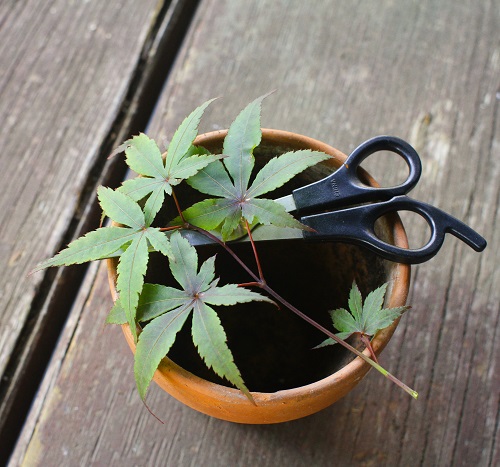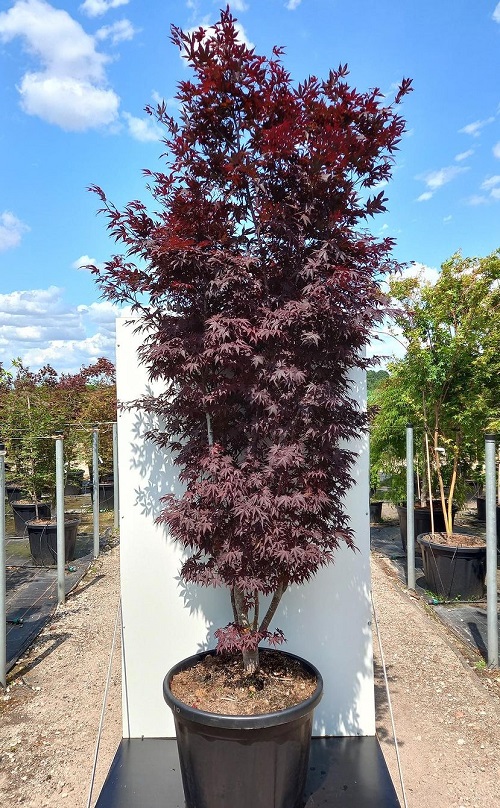Fireglow Japanese Maple offers a fiery foliage that looks great in every type of garden setting! Here’s how to grow it!

Fireglow Japanese Maple is a fantastic specimen for anyone looking forward to create a natural focal point of colors in their garden! Let’s have a look at it!
Check out Tamukeyama Japanese Maple Growing Information
Fireglow Japanese Maple Information

The Fireglow Japanese Maple boasts a stunning display of crimson foliage in autumn and a deep burgundy-red hue during the summer. Its open canopy sets it apart from other varieties, and it thrives well even in sunnier spots.
Revered for its impeccable form, growth pattern, and captivating autumn shades, Japanese maples remain among the most sought-after choices for compact trees in landscaping.
Family: Sapindaceae
Native Place: The Fireglow Japanese Maple (Acer palmatum ‘Fireglow’) is native to Japan, Korea, and China.
Appearance: It is a small deciduous tree that grows with a compact, rounded form. The branches are somewhat drooping, and the tree has a slow growth rate.
Height and Spread: This tree typically reaches a height of 10 to 15 feet (3 to 4.5 meters) and has a spread of about 8 to 12 feet (2.4 to 3.6 meters).
Flowers: The Fireglow Japanese Maple produces inconspicuous small purple-red flowers in spring, but they are not a prominent feature of the tree.
Foliage: The most distinctive feature of the Fireglow Japanese Maple is its foliage. The leaves are deeply lobed with serrated edges, and they emerge in spring with a vibrant red color that turns to a deep purplish-red as they mature. The foliage maintains its rich color throughout the summer months.
This tree is favored for its striking foliage, which can add a splash of color to gardens and landscapes. It prefers partial shade and well-draining soil. Pruning can be done to maintain its shape and size. The Fireglow Japanese Maple is often used as an ornamental tree in gardens, parks, and other outdoor spaces due to its attractive appearance.
Learn How to Grow a Japanese Maple Tree in a Pot here
Propagating Fireglow Japanese Maple

Methods to propagate Fireglow Japanese Maple:
- Air Layering
- Softwood Cuttings
- Grafting
- Easiest Method: Air Layering
Air layering is one of the easiest methods to propagate Fireglow Japanese Maple. Here’s how it works:
- Choose a healthy branch on the parent Fireglow Japanese Maple tree that is about one year old and has a diameter of around 1/4 to 1/2 inch.
- In the spring, make a small upward slanting cut about one-third through the branch. This cut should be around 4 inches long.
- Dust the cut with rooting hormone to encourage root growth.
- Wrap the cut area with damp sphagnum moss to keep it moist.
- Cover the moss with plastic wrap and secure it with tape at both ends. This creates a humid environment that promotes root formation.
- Wait several weeks to a few months for roots to develop. You can check by gently removing the plastic wrap and moss.
- Once you see a good amount of roots, carefully cut the branch below the rooted area.
- Pot the rooted branch in a well-draining potting mix and keep it in a sheltered spot until it establishes itself.
Check out the Best Japanese Plants for Your Garden here
Best Pot Size for Fireglow Japanese Maple
Young Trees
- Initial Potting: For young trees or saplings, a 12-16 inches pot is usually sufficient.
Mature Trees
- Long-term Planting: For more mature trees, go for a 22-26 inches pot or larger to accommodate the root system.
Ensure that the pot has sufficient drainage holes to prevent waterlogging, as poor drainage can lead to root rot.
Requirements for Growing Fireglow Japanese Maple

Light
The Fireglow Japanese Maple thrives in areas with full sun to partial shade. Sunlight for atleast 4-5 hours would be great for its growth.
It’s important to avoid exposing it to intense afternoon sun or reflective sunlight, like near a white wall on the southern side. This helps protect its vibrant red leaves and overall health.
Soil
Fireglow Japanese Maples thrive in well-draining, slightly acidic soil rich in organic matter. Here’s a best mix you can use:
- 3 parts Potting Soil
- 2 parts Coir or Peat Moss
- 1 part Perlite or Pumice
- 1 part Compost
- 0.5 part Pine Bark
This tailored mix provides excellent drainage, retains the right amount of moisture, and offers a rich blend of organic nutrients. Use this potting mix for growing in Fireglow Japanese Maple containers.
Water
Proper watering is essential for the healthy growth of a Fireglow Japanese Maple tree. Different stages of growth have unique watering needs, and understanding these can help ensure that your tree thrives.
Seedling Stage
- Water daily or every other day.
- Light watering, just enough to keep the soil moist but not waterlogged.
- Use a spray bottle or gentle shower setting on a hose to avoid dislodging the seedling.
Young Trees (1-3 Years)
- Water regularly, ensuring the soil is never getting completely dry.
- Early morning or late afternoon is the best time to water to reduce evaporation.
Mature Trees (4 Years and Above)
- Weekly watering may be adequate, but this can vary depending on weather conditions.
- Use a soaker hose or drip irrigation for deep watering.
- Less frequent but deeper watering is generally more beneficial for mature trees.
Temperature and Humidity
Optimal Temperature Range
- Spring and Summer: 65-85°F (18-29°C)
- Fall: 50-70°F (10-21°C)
- Winter: 20-40°F (-7 to 4°C)
Discover Best Japanese Holly Bonsai Tree Pictures
Fireglow Japanese Maple Care

Fertilizer
To ensure the optimal growth of your Fireglow Japanese Maple, choose a balanced, slow-release fertilizer with an NPK ratio of 10-10-10 or 14-14-14. Best applied in early spring, just before new growth starts, or in late fall after the tree has lost its leaves.
Dosage
- Young Trees (1-3 Years): Use approximately 1 to 2 cups of the slow-release granular fertilizer, once in 3-4 months.
- Mature Trees (4 Years and Older): Use 2 to 4 cups, depending on the size of the tree and the manufacturer’s recommendations, once in 3-4 months.
Spread the fertilizer evenly in the soil, making sure it is away from the trunk.
Mulching
Use organic materials like wood chips or compost, applying a 2 to 4-inch layer around the tree’s base while keeping it away from the trunk. This conserves moisture, regulates soil temperature, suppresses weeds, and enriches soil nutrients.
Apply mulch in spring or early summer and replenish annually. Quality mulch prevents pests and diseases. Remember to water appropriately and avoid piling mulch against the trunk.
Pruning
Fireglow Japanese Maple generally requires minimal pruning. It’s advisable to avoid heavy pruning for any tree younger than 10 years old. It’s best to leave long, flexible branches untouched as they develop into graceful features over time.
For mature trees, focus on pruning lower branches and getting rid of any branches that cross over, which will enhance the tree’s look.
Removing dead, sick, or damaged branches is also important. You can influence the tree’s appearance by deciding if you want a single main trunk or multiple trunks.
Overwintering
Overwintering Fireglow Japanese Maple involves protecting the plant from harsh winter conditions. Before frost, mulch around the base, water thoroughly, and wrap the tree with burlap to shield it from cold winds.
Avoid fertilizing and prune sparingly to prevent new growth. Place the potted plants in a sheltered spot with indirect sunlight. Regularly check soil moisture.
Pests:
Aphids: These tiny insects can cluster on new growth, causing distortion and discoloration of leaves. They secrete honeydew, which can attract other pests and promote the growth of sooty mold.
Scale Insects: These pests attach themselves to the stems and leaves, sucking out sap and weakening the tree. They often appear as small bumps or shells.
Japanese Beetles: These beetles feed on the leaves of the tree, causing skeletonization of the foliage. Their feeding can significantly damage the appearance of the tree.
Diseases:
Anthracnose: This fungal disease can cause leaf spots, discoloration, and even defoliation. It thrives in wet conditions and can be particularly problematic in rainy seasons.
Verticillium Wilt: This soil-borne fungus can cause wilting, leaf yellowing, and eventual dieback of branches. Infected trees may not recover and often need to be removed.
Powdery Mildew: This fungal disease appears as a white powdery substance on the leaves, causing them to distort and curl. It’s more common in humid conditions.
Prevention and Management:
- Proper Maintenance: Keeping your Fireglow Japanese Maple healthy through proper watering, mulching, and fertilization can help it resist pests and diseases.
- Pruning: Regularly removing dead or diseased branches can prevent the spread of diseases and create a healthier environment for the tree.
- Monitoring: Regularly inspect your tree for any signs of pests or diseases. Early detection allows for quicker intervention.
- Cultural Practices: Avoid overhead watering, as wet foliage can promote disease. Provide good air circulation around the tree to reduce humidity.
- Chemical Control: In severe cases, chemical treatments like insecticides or fungicides may be necessary. Consult with a local arborist or garden expert before using any chemicals.
Check out Japanese Garden Plants You Can Grow Indoors here
Landscaping Uses of Fireglow Japanese Maple
1. Focal Point
Single Specimen
- Ideal for creating a central point of interest in your garden.
- Works well in front yards as a striking attention-grabber.
Group Planting
- Create a mini grove of Fireglow Japanese Maples for a larger focal area.
2. Border and Edging
Natural Border
- Plant in a line to create a natural demarcation between different garden zones.
Entryway
- Plant one tree on each side of an entrance to create a welcoming portal.
3. Container Planting
Potted Fireglow Japanese Maples are great for patios and terraces.
4. Zen and Japanese Gardens
Complement stone elements, water features, and other Japanese flora.
5. Understory Planting
Plant beneath larger trees where they get partial shade, which they prefer.
6. Ponds and Water Features
Plant near a water feature to enjoy the reflection of its vibrant foliage in the water.
7. Mixed Borders
Mix with other foliage plants or flowering shrubs to create a lush, textured border.
8. Wildlife Attraction
Though not its primary use, its seeds can attract birds during fall.
9. Seasonal Interest
Use to provide vibrant color in seasons where other plants may not be at their peak.
Fireglow Japanese Maple – FAQs
Q1: Can I grow Fireglow Japanese Maple in a container?
A: Yes, Fireglow Japanese Maples can be grown in containers. Choose a large pot with good drainage and use a well-draining potting mix. Container plants may need more frequent watering and care.
Q2: How do I maintain the vibrant red color of the leaves?
A: The intense red color of Fireglow Japanese Maple leaves is more pronounced in cooler temperatures. Providing some shade during hot summer months and maintaining proper soil moisture can help retain the vibrant color.
Learn How to Make a Japanese Balcony Garden here
Q3: Why are the leaves of my Fireglow Japanese Maple turning brown and crispy at the edges?
A: This could be a sign of inadequate watering, especially during hot or windy periods. Ensure that the tree receives sufficient water, and consider increasing humidity around the tree if needed.
Q4: How long does it take for a young Fireglow Japanese Maple to reach its full height?
A: Growth rate can vary, but generally, it takes several years for a young Fireglow Japanese Maple to reach its full height. Proper care and conditions can contribute to a healthier and faster growth rate.


